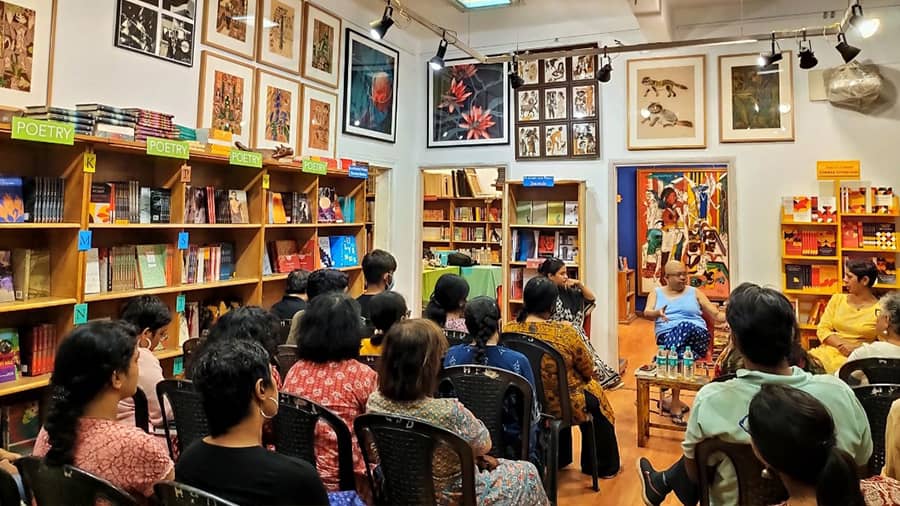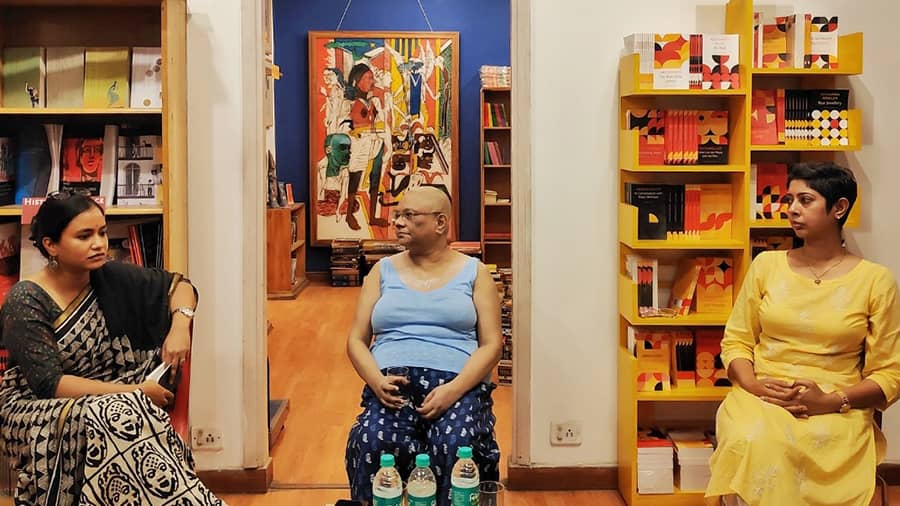Women translators, their position, roles and responsibilities in contemporary society were the focus of a discussion on ‘Type-Set Women who Translate’ hosted by Seagull Books and Jadavpur University Press on August 26.
In conversation were Sunandini Banerjee, senior editor and graphic designer, Seagull Books; and Rita Ray, professor of Portuguese literature and language and translator. The talk was moderated by Suchismita Ghosh, copy editor, Bengali titles, Jadavpur University Press.
The session at the Seagull Bookstore was attended by students of translation, translators and academics.

Students of translation, translators and colleagues from the publishing industry attended the discussion at Seagull Bookstore Soumyajit Dey
Acknowledgement of women translators
With women under-representation standing out in history, the need for women to be acknowledged in this field is all the more important. The speakers narrated their personal experiences and shared their opinion to offer a broader perspective.
Banerjee, who has translated Nabarun Bhattacharya’s Herbert and Mahasweta Devi's Bedanabala, said the “visible and invisible labour” needs to be brought into focus. ‘’I think the endeavour has become necessary because something has to be done to address the unequal balance of power that has carried on for the longest time. It is a certain kind of searchlight that needs to be shown on the visible and invisible labour,” she said.
‘’Women in Translation is focusing on a movement within the publishing world. I think there should be a similar movement for women in every industry. One thing that I like about the idea of women in translation is that it is adopted by readers, bookshop owners, and booksellers; so, the whole community is on board,” Banerjee said.
Visibility of women translators
Translators’ names have now found a place on the book cover, but it was not always so.
‘’In 1993, when I started teaching Portuguese at Jadavpur University. Me and my senior students started translating Portuguese poems. We had translated almost 100 poems but we had no idea how or where to publish them. In 1994, I went to Jawaharlal Nehru University to ask the JNU Portuguese professor to help me edit the poems,’’ said Ray, who went on to marry the said professor.
‘’He had seven brothers, one of whom was an artist. He found a publisher. In 1994, the publisher charged Rs 16,000 for a 90-page book. My brother-in-law did everything because he was under the impression that the book was his brother’s work and mine. So that’s why he did it and paid the money. That was my first instance with visibility,’’ Ghosh said.
From a translator’s perspective, how does one choose a text and how has publicity merged with the art? Ray, who has been involved with the process for almost three decades, said she translated authors or works she liked. “I can’t do anything that I don’t like. In my entire career, I have had three cases of commissioned work.
I read the book as a reader and then I move on to translation. My agenda was to make Portuguese literature available to Bengal. I thought my job was to translate and hand over the book to the publisher. But it’s not that. Now I see that you have to publicise,’’ she said. Ray has translated the works of Fernando Pessoa, Mia Couto, Rui Zink from Portuguese to Bengali and is currently working on translating Jean-Paul Sartre and Aimé Césaire from French to Bengali.
Banerjee elaborated on the translator and publisher’s profession. ‘‘Irrespective of data and retrospective analysis of strategies, no publisher can guarantee that the book will sell. Even after organising an over-the-top publicity machine, ultimately it comes down to the reader’s curiosity and word of mouth. It still is that primitive. ‘’
“At Seagull, we look at literature in a certain kind of way. We are not necessarily looking at bestsellers. Yes, we have to survive. But we would rather do it with a body of a different kind of literature. Why keep repeating things that is already available? We tend to look at the style of writing and the kinds of narrative,” Banerjee said.
Translators vs prejudiced texts
The conversation concluded with a keen eye on the role of a translator, especially with a prejudiced text in hand.
“We have to be very loyal to your source texts. So, if there is any prejudice, I will translate it word for word and then put out a footnote,” Ray said.
Banerjee said the act of translation is to render as closely as possible something from one language to the other while acknowledging that there will be some loss. “It’s not an editing procedure, rewriting or adaptation.
We get translators who assume that they are here to make the source text better than it is. This is a prevalent problem. If you are a sensitive translator, you add an introduction, translator’s note or a footnote depending on the nature of the text. If it is even more outrageous than that, then you take a call whether you want to translate it at all.’’
